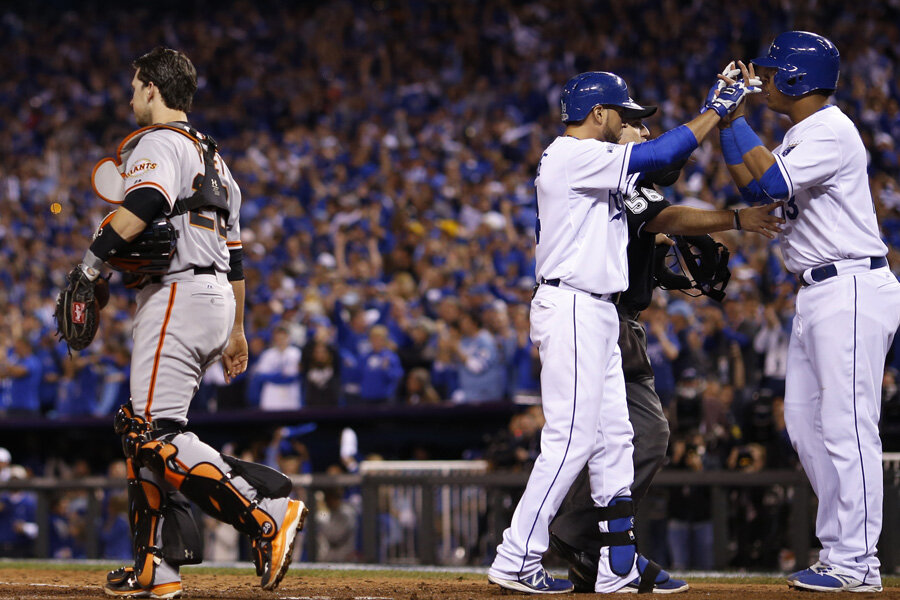World Series 2014: Royals rebound for Game 2 win over Giants
Loading...
| Kansas City, Mo.
The first showdown of brilliant bullpens went to the Kansas City Royals.
After Kansas City took the lead with a five-run sixth inning, the trio of Kelvin Herrera, Wade Davis and All-Star closer Greg Holland shut down the hot-hitting San Francisco Giants.
Kansas City cruised from there to a 7-2 victory Wednesday night, evening the World Series at a game apiece as it shifts to the Bay Area for the next three games.
"It's a huge luxury for me," Royals manager Ned Yost said. "After the sixth inning, my thinking is done. I don't have to mix and match."
Nope, just call on the gas.
Herrera's blistering 101-mph fastballs kept the free-swinging Giants on their heels, and Davis breezed through a perfect eighth inning with his own heat. The hard-throwing Holland worked around a single in the ninth, punctuating the victory by punching the air.
"We've got a pretty good recipe for success with Herrera, Davis and Holland," Yost said.
Meanwhile, the San Francisco bullpen that had the fifth-best ERA in the majors and had tossed 12 2-3 scoreless innings in its last four games was lit up like the crown-shaped scoreboard in center field.
With the game tied 2-all and Giants starter Jake Peavy in trouble in the sixth, manager Bruce Bochy summoned reliever Jean Marchi to face Billy Butler. The big designated hitter responded with a hard single to left field, giving the Royals a 3-2 lead and igniting a crowd that had been waiting since a 7-1 loss in Game 1 for something to get excited bout.
Playing the matchups, Bochy called on Javier Lopez to face Alex Gordon, and he did his job. The slumping Gordon flied out to left field for the first out of the inning.
"Those are the matchups we were trying to get," Bochy said.
Bochy ambled out to the mound once more, this time asking for Hunter Strickland. This time, the move backfired — Salvador Perez ripped a two-run double into the gap in left field, and Omar Infante sent a pitch soaring into the bullpen in left field to make it 7-2.
"I let the team down," said Strickland, who has allowed five postseason homers after giving up three during the regular season — all at Double-A.
He also let his emotions get the better of him.
Infante was rounding the bases as Perez headed for home, and Strickland got into a shouting match with the Royals' big catcher. Players from both benches streamed onto the field, and a few of the Royals' relievers ran in from the outfield bullpen, before order was restored.
"He started to look at me, so I asked him like, 'Hey, why you look at me?'" Perez said. "So he was telling me, 'Get out of here, whatever.' So I don't know. 'You don't have to treat me like that. Look at Omar. Omar hit a bomb. I didn't hit a bomb. I hit a double.'"
Regardless, one thing had become clear: The World Series suddenly had some life.
Now it shifts to AT&T Park, a quirky ballpark that very few Royals have played in. Jeremy Guthrie will be on the mound for them in Game 3 on Friday night, while veteran Tim Hudson makes the first World Series start of his 16-year big league career for San Francisco.
"We battled and played well. We hit the ball hard," Peavy said. "We had good at-bats. I thought we battled. That sixth inning, it was a 2-2 game. Unfortunately, they got going."
And with the combination of hard-throwing rookie Yordano Ventura, who allowed two runs while pitching into the sixth inning, and the Royals' lockdown bullpen, that was enough.
"With their pitching and our pitching, and the way both teams play, we're going to have a fight, I think, every game," Bochy said.
Figuratively speaking, of course.
Even if the teams nearly came to blows Wednesday night.
"Every one of us has been roughed up before," said Giants reliever Jeremy Affeldt, who once pitched for Kansas City. "And we've all been part of something that's gotten out of hand. That's what we signed up for. That's our job. We go out there and do good, we still have a short memory.
"It's over," he added. "We move on."





